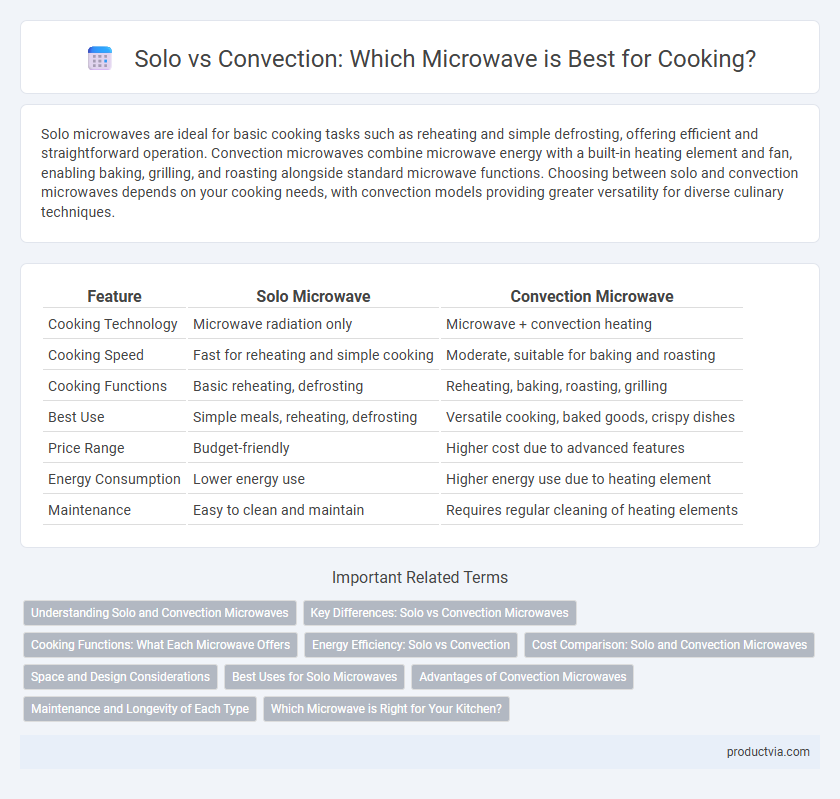Solo microwaves are ideal for basic cooking tasks such as reheating and simple defrosting, offering efficient and straightforward operation. Convection microwaves combine microwave energy with a built-in heating element and fan, enabling baking, grilling, and roasting alongside standard microwave functions. Choosing between solo and convection microwaves depends on your cooking needs, with convection models providing greater versatility for diverse culinary techniques.
Table of Comparison
| Feature | Solo Microwave | Convection Microwave |
|---|---|---|
| Cooking Technology | Microwave radiation only | Microwave + convection heating |
| Cooking Speed | Fast for reheating and simple cooking | Moderate, suitable for baking and roasting |
| Cooking Functions | Basic reheating, defrosting | Reheating, baking, roasting, grilling |
| Best Use | Simple meals, reheating, defrosting | Versatile cooking, baked goods, crispy dishes |
| Price Range | Budget-friendly | Higher cost due to advanced features |
| Energy Consumption | Lower energy use | Higher energy use due to heating element |
| Maintenance | Easy to clean and maintain | Requires regular cleaning of heating elements |
Understanding Solo and Convection Microwaves
Solo microwaves use microwave radiation solely for heating and reheating food, ideal for simple tasks like defrosting and reheating leftovers with energy efficiency. Convection microwaves combine microwave energy with a heating element and fan, enabling baking, grilling, and roasting alongside regular microwave functions, offering versatility for various cooking methods. Understanding the difference between solo and convection microwaves helps users select the right appliance based on cooking needs and food types.
Key Differences: Solo vs Convection Microwaves
Solo microwaves use microwave radiation solely for quick heating and reheating, making them energy-efficient and ideal for simple tasks like defrosting or warming food. Convection microwaves combine microwave energy with a heating element and fan to circulate hot air, enabling baking, roasting, and grilling alongside standard microwave functions. The key difference lies in cooking versatility, where convection models provide more advanced cooking options, while solo microwaves focus on speed and simplicity.
Cooking Functions: What Each Microwave Offers
Solo microwaves primarily offer basic cooking functions such as reheating, defrosting, and simple cooking tasks using microwave radiation alone. Convection microwaves combine these standard microwave functions with an integrated heating element and fan, enabling baking, grilling, and roasting, which results in crispier and evenly cooked dishes. This dual functionality makes convection microwaves ideal for users seeking versatile cooking options beyond traditional microwave use.
Energy Efficiency: Solo vs Convection
Solo microwaves consume less energy by using microwave radiation exclusively for heating food, making them ideal for basic reheating tasks with minimal power consumption. Convection microwaves combine microwave energy with a heating element and fan, which increases energy usage but enables faster and more even cooking, ideal for baking and roasting. Energy efficiency depends on usage type; solo microwaves are better for simple heating, while convection models offer multifunctionality at higher energy costs.
Cost Comparison: Solo and Convection Microwaves
Solo microwaves generally have a lower initial purchase price compared to convection microwaves, making them a budget-friendly option for basic reheating and simple cooking tasks. Convection microwaves, which combine microwave energy with a heating element and fan, tend to be more expensive due to their advanced features and versatility, enabling baking and grilling along with standard microwave functions. Long-term energy costs are comparable, but convection models may use slightly more power when utilizing the convection function, impacting overall electricity expenses marginally.
Space and Design Considerations
Solo microwaves feature a compact design ideal for small kitchens or limited counter space, offering straightforward use without additional cooking modes. Convection microwaves tend to be larger due to integrated heating elements and fans, requiring more space but enabling versatile functions such as baking, roasting, and grilling. When choosing between the two, consider available kitchen space and whether multifunctionality outweighs the need for a smaller footprint.
Best Uses for Solo Microwaves
Solo microwaves are ideal for simple, everyday cooking tasks such as reheating leftovers, defrosting frozen foods, and cooking ready-to-eat meals. Their straightforward design offers efficient heating without the added features of grilling or baking, making them perfect for users with basic cooking needs or limited kitchen space. Solo microwaves are also typically more affordable and compact, providing a cost-effective solution for quick meal preparation.
Advantages of Convection Microwaves
Convection microwaves combine microwave energy with a heating element and fan, enabling even cooking and browning that solo microwaves cannot achieve. They provide versatile cooking options such as baking, roasting, and grilling, which expand meal preparation possibilities beyond simple reheating. This multifunctionality reduces the need for separate appliances, saving kitchen space and enhancing convenience.
Maintenance and Longevity of Each Type
Solo microwaves have fewer components, resulting in simpler maintenance and typically longer durability due to the absence of additional heating elements. Convection microwaves include a fan and heating element to enable baking and roasting, which require more regular cleaning and routine checks to prevent wear and ensure optimal performance. Proper upkeep of convection models is essential to preserve their longevity, while solo microwaves often experience fewer mechanical issues over time.
Which Microwave is Right for Your Kitchen?
Solo microwaves offer quick, efficient heating and basic cooking functions, ideal for simple meal preparation and small kitchens with limited counter space. Convection microwaves combine microwave energy with a heating element and a fan, enabling baking, roasting, and crisping, which adds versatility for diverse culinary tasks. Choosing between solo and convection depends on cooking habits and kitchen needs, with solo microwaves suiting everyday reheating and convection models fitting those seeking multifunctional appliances.
Solo vs Convection for microwave cooking Infographic

 productvia.com
productvia.com